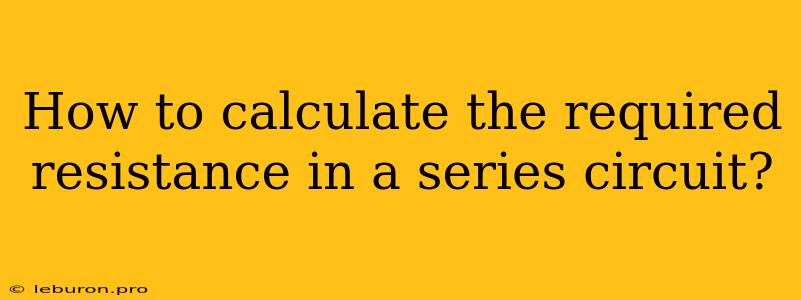Understanding how to calculate the required resistance in a series circuit is crucial for anyone working with electronics. A series circuit is a basic configuration where components are connected end-to-end, forming a single path for current to flow. The resistance in a series circuit plays a key role in determining the current flow and voltage drop across each component. This article will delve into the fundamentals of series circuits and provide a step-by-step guide on calculating the required resistance.
Understanding Series Circuits
A series circuit is characterized by the following key features:
- Single Path: All components are connected in a single, uninterrupted path for current to flow. This means that the current passing through each component is the same.
- Voltage Division: The total voltage applied to the circuit is divided among the individual components in proportion to their resistance.
- Total Resistance: The total resistance of a series circuit is the sum of the individual resistances of each component.
Calculating Required Resistance
To calculate the required resistance in a series circuit, we need to consider the following factors:
- Voltage (V): The total voltage applied across the circuit.
- Current (I): The desired current flow through the circuit.
- Resistances of Other Components (R1, R2, ...): The resistances of any other components already present in the series circuit.
Ohm's Law
The fundamental relationship between voltage, current, and resistance is described by Ohm's Law:
V = I x R
Where:
- V is the voltage in volts (V)
- I is the current in amperes (A)
- R is the resistance in ohms (Ω)
Steps to Calculate Required Resistance
-
Determine the Desired Current (I): This is usually specified by the application or the device you are connecting.
-
Calculate the Total Resistance (Rtotal): This is the total resistance needed for the circuit to achieve the desired current with the given voltage. Use Ohm's Law:
Rtotal = V / I
-
Calculate the Resistance of Existing Components: If you have other components already in the series circuit, calculate their combined resistance (Rexisting).
-
Calculate the Required Resistance (Rrequired): Subtract the resistance of existing components from the total resistance:
Rrequired = Rtotal - Rexisting
Example Calculation
Let's say we want to build a circuit with a 12V battery and a desired current of 0.5A. We also have a resistor with a resistance of 10Ω already in the circuit.
-
Desired Current (I): 0.5A
-
Total Resistance (Rtotal):
Rtotal = V / I = 12V / 0.5A = 24Ω
-
Resistance of Existing Components (Rexisting): 10Ω
-
Required Resistance (Rrequired):
Rrequired = Rtotal - Rexisting = 24Ω - 10Ω = 14Ω
Therefore, we need a resistor with a resistance of 14Ω to achieve a current of 0.5A in this circuit.
Choosing the Right Resistor
Once you have calculated the required resistance, you need to choose a resistor with the appropriate value and power rating.
-
Resistance Value: Choose a resistor with a resistance value closest to the calculated value.
-
Power Rating: The power rating of a resistor determines how much power it can safely dissipate. The power dissipated by a resistor can be calculated using the following formula:
P = I² x R
Where:
- P is the power in watts (W)
- I is the current in amperes (A)
- R is the resistance in ohms (Ω)
It's important to choose a resistor with a power rating greater than the calculated power dissipation to prevent overheating and damage.
Practical Considerations
- Tolerance: Resistors have a tolerance, which means their actual resistance can vary slightly from the marked value. Consider this variation when choosing resistors.
- Power Dissipation: Ensure the resistor you choose has an adequate power rating to handle the expected power dissipation.
- Temperature: Resistors can change resistance with temperature. If your circuit is operating in a high-temperature environment, choose a resistor with a low temperature coefficient.
- Voltage Rating: If the voltage across the resistor exceeds its voltage rating, it can cause damage. Choose a resistor with a voltage rating greater than the voltage it will experience.
Conclusion
Calculating the required resistance in a series circuit is essential for achieving the desired current flow and voltage distribution. By understanding the principles of series circuits, Ohm's Law, and the factors involved in resistor selection, you can confidently design and build electronic circuits that meet your specifications. Remember to always prioritize safety and select components with appropriate ratings to ensure the long-term stability and functionality of your circuit.
